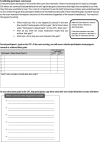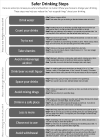Harm reduction with pharmacotherapy for homeless people with alcohol dependence: protocol for a randomized controlled trial
- PMID: 24846619
- PMCID: PMC4104260
- DOI: 10.1016/j.cct.2014.05.008
Harm reduction with pharmacotherapy for homeless people with alcohol dependence: protocol for a randomized controlled trial
Abstract
Background: Interventions requiring abstinence from alcohol are neither preferred by nor shown to be highly effective with many homeless individuals with alcohol dependence. It is therefore important to develop lower-threshold, patient-centered interventions for this multimorbid and high-utilizing population. Harm-reduction counseling requires neither abstinence nor use reduction and pairs a compassionate style with patient-driven goal-setting. Extended-release naltrexone (XR-NTX), a monthly injectable formulation of an opioid receptor antagonist, reduces craving and may support achievement of harm-reduction goals. Together, harm-reduction counseling and XR-NTX may support alcohol harm reduction and quality-of-life improvement.
Aims: Study aims include testing: a) the relative efficacy of XR-NTX and harm-reduction counseling compared to a community-based, supportive-services-as-usual control, b) theory-based mediators of treatment effects, and c) treatment effects on publicly funded service costs.
Methods: This RCT involves four arms: a) XR-NTX+harm-reduction counseling, b) placebo+harm-reduction counseling, c) harm-reduction counseling only, and d) community-based, supportive-services-as-usual control conditions. Participants are currently/formerly homeless, alcohol dependent individuals (N=300). Outcomes include alcohol variables (i.e., craving, quantity/frequency, problems and biomarkers), health-related quality of life, and publicly funded service utilization and associated costs. Mediators include 10-point motivation rulers and the Penn Alcohol Craving Scale. XR-NTX and harm-reduction counseling are administered every 4weeks over the 12-week treatment course. Follow-up assessments are conducted at weeks 24 and 36.
Discussion: If found efficacious, XR-NTX and harm-reduction counseling will be well-positioned to support reductions in alcohol-related harm, decreases in costs associated with publicly funded service utilization, and increases in quality of life among homeless, alcohol-dependent individuals.
Trial registration: ClinicalTrials.gov NCT01932801.
Keywords: Alcohol dependence; Alcohol treatment; Extended-release naltrexone; Harm reduction; Homelessness.
Copyright © 2014 Elsevier Inc. All rights reserved.
Figures




Similar articles
-
Extended-release naltrexone and harm reduction counseling for chronically homeless people with alcohol dependence.Subst Abus. 2015;36(1):21-33. doi: 10.1080/08897077.2014.904838. Epub 2015 Jan 22. Subst Abus. 2015. PMID: 24779575
-
Combining behavioral harm-reduction treatment and extended-release naltrexone for people experiencing homelessness and alcohol use disorder in the USA: a randomised clinical trial.Lancet Psychiatry. 2021 Apr;8(4):287-300. doi: 10.1016/S2215-0366(20)30489-2. Epub 2021 Mar 10. Lancet Psychiatry. 2021. PMID: 33713622 Free PMC article. Clinical Trial.
-
Extended-release vs. oral naltrexone for alcohol dependence treatment in primary care (XON).Contemp Clin Trials. 2019 Jun;81:102-109. doi: 10.1016/j.cct.2019.04.006. Epub 2019 Apr 12. Contemp Clin Trials. 2019. PMID: 30986535 Free PMC article. Clinical Trial.
-
Intramuscular extended-release naltrexone: current evidence.Ann N Y Acad Sci. 2011 Jan;1216:144-66. doi: 10.1111/j.1749-6632.2010.05900.x. Ann N Y Acad Sci. 2011. PMID: 21272018 Review.
-
Extended-release intramuscular naltrexone (VIVITROL®): a review of its use in the prevention of relapse to opioid dependence in detoxified patients.CNS Drugs. 2013 Oct;27(10):851-61. doi: 10.1007/s40263-013-0110-x. CNS Drugs. 2013. PMID: 24018540 Review.
Cited by
-
The life-enhancing alcohol-management program: Results from a 6-month nonrandomized controlled pilot study assessing a community based participatory research program in housing first.J Community Psychol. 2020 Apr;48(3):763-776. doi: 10.1002/jcop.22291. Epub 2019 Nov 28. J Community Psychol. 2020. PMID: 31778585 Free PMC article.
-
Randomized controlled trial of harm reduction treatment for alcohol (HaRT-A) for people experiencing homelessness and alcohol use disorder.Int J Drug Policy. 2019 May;67:24-33. doi: 10.1016/j.drugpo.2019.01.002. Epub 2019 Mar 6. Int J Drug Policy. 2019. PMID: 30851620 Free PMC article. Clinical Trial.
-
Safer-use strategies in the context of harm-reduction treatment for people experiencing homelessness and alcohol use disorder.Int J Drug Policy. 2024 Jul;129:104448. doi: 10.1016/j.drugpo.2024.104448. Epub 2024 Jun 20. Int J Drug Policy. 2024. PMID: 38905941 Free PMC article. Clinical Trial.
-
Extended-release Naltrexone Is Not Linked to Hepatotoxicity in Adults Experiencing Homelessness and Alcohol Use Disorder.J Addict Med. 2023 May-Jun 01;17(3):363-366. doi: 10.1097/ADM.0000000000001121. Epub 2023 Jan 5. J Addict Med. 2023. PMID: 37267194 Free PMC article. Clinical Trial.
-
Characterizing components of and attendance at resident-driven Housing First programming in the context of community-based participatory research.J Community Psychol. 2021 Jul;49(5):1376-1392. doi: 10.1002/jcop.22491. Epub 2020 Dec 10. J Community Psychol. 2021. PMID: 33301627 Free PMC article.
References
-
- Grant BF, Dawson DA, Stinson FS, Chou SP, Dufour MC, Pickering RP. The 12-month prevalence and trends in DSM-IV alcohol abuse and dependence: United States, 1991-1992 and 2001-2002. Drug and Alcohol Dependence. 2004;74:223–234. - PubMed
-
- Larimer ME, Malone DK, Garner MD, et al. Health Care and Public Service Use and Costs Before and After Provision of Housing for Chronically Homeless Persons With Severe Alcohol Problems. Journal of the American Medical Association. 2009;301:1349–1357. - PubMed
Publication types
MeSH terms
Substances
Associated data
Grants and funding
LinkOut - more resources
Full Text Sources
Other Literature Sources
Medical

